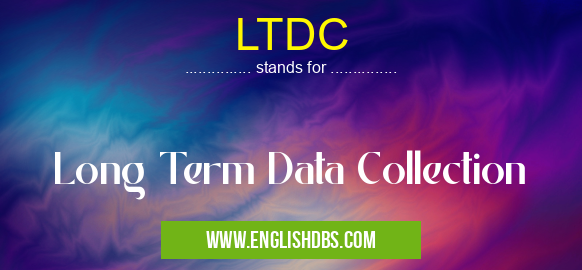What does LTDC mean in UNCLASSIFIED
LTDC stands for Long Term Data Collection. It is a process of gathering data over an extended period, typically years or even decades. LTDC is used in a wide variety of fields, including science, business, and social research.

LTDC meaning in Unclassified in Miscellaneous
LTDC mostly used in an acronym Unclassified in Category Miscellaneous that means Long Term Data Collection
Shorthand: LTDC,
Full Form: Long Term Data Collection
For more information of "Long Term Data Collection", see the section below.
Purpose of LTDC
The primary purpose of LTDC is to track changes and trends over time. By collecting data over a long period, researchers can identify patterns and relationships that would not be apparent from a single snapshot in time. LTDC can also be used to evaluate the effectiveness of interventions or programs, and to track the progress of individuals or groups over time.
Methods of LTDC
There are a variety of methods that can be used for LTDC, including:
- Observational studies: These studies involve observing and recording data without intervening in the natural course of events.
- Experimental studies: These studies involve manipulating one or more variables to determine their effects on the outcome of interest.
- Surveys: These studies involve collecting data from a sample of individuals using questionnaires or interviews.
Benefits of LTDC
LTDC offers a number of benefits, including:
- Provides a more complete picture of the phenomenon being studied. By collecting data over a long period, researchers can gain a better understanding of the factors that influence it and how it changes over time.
- Can help to identify trends and patterns. LTDC can help researchers to identify trends and patterns that would not be apparent from a single snapshot in time. This information can be used to make predictions about the future and to develop policies and interventions.
- Can help to evaluate the effectiveness of interventions or programs. LTDC can be used to track the progress of individuals or groups over time and to evaluate the effectiveness of interventions or programs.
Challenges of LTDC
LTDC also presents a number of challenges, including:
- Cost: LTDC can be expensive to conduct, especially if it involves collecting data from a large number of participants over a long period of time.
- Time: LTDC can be time-consuming to conduct, especially if it involves collecting data from a large number of participants over a long period of time.
- Data management: LTDC can generate a large amount of data, which can be difficult to manage and analyze.
Essential Questions and Answers on Long Term Data Collection in "MISCELLANEOUS»UNFILED"
What is Long Term Data Collection (LTDC)?
Long Term Data Collection (LTDC) refers to the systematic and continuous gathering of data over an extended period, typically years or decades. LTDC is designed to monitor changes and trends in specific parameters or phenomena, and provide insights into long-term patterns and behaviors.
What are the benefits of LTDC?
LTDC offers several benefits, including:
- Monitoring long-term trends and changes in data, allowing for identification of patterns and anomalies.
- Providing a historical record for analysis and comparison, enabling the study of temporal variations and dependencies.
- Facilitating the development of predictive models and forecasting by identifying key relationships and correlations.
- Supporting decision-making processes based on robust and reliable long-term data.
What are some examples of LTDC projects?
LTDC projects span various fields and applications, such as:
- Climate change monitoring, tracking weather patterns, temperature changes, and sea level rise.
- Environmental monitoring, assessing air and water quality, biodiversity, and ecosystem health.
- Health research, studying disease prevalence, treatment outcomes, and population health trends.
- Economic and social research, examining consumption patterns, employment trends, and demographic shifts.
What are the challenges in LTDC?
LTDC projects often face challenges, including:
- Maintaining data quality and consistency over long periods.
- Ensuring data security and privacy, especially for sensitive or personal information.
- Managing large volumes of data and developing efficient storage and retrieval systems.
- Addressing changes in data collection methods or technology over time, requiring data harmonization.
How is LTDC data used?
LTDC data is utilized in various ways, such as:
- Identifying trends and patterns, informing policy and decision-making processes.
- Conducting research, testing hypotheses, and advancing scientific knowledge.
- Developing models and forecasting future outcomes, supporting planning and resource allocation.
- Evaluating the effectiveness of interventions and programs, assessing their impact over time.
Final Words: LTDC is a valuable tool for researchers who need to track changes and trends over time. However, it is important to be aware of the challenges involved in conducting LTDC and to plan carefully before embarking on a LTDC project.
LTDC also stands for: |
|
| All stands for LTDC |
